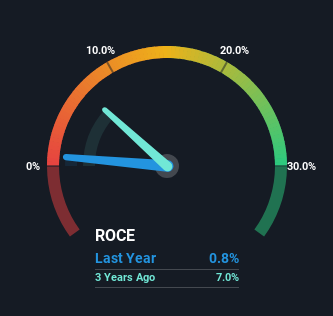Time Watch Investments (HKG:2033) May Have Issues Allocating Its Capital

When we're researching a company, it's sometimes hard to find the warning signs, but there are some financial metrics that can help spot trouble early. When we see a declining return on capital employed (ROCE) in conjunction with a declining base of capital employed, that's often how a mature business shows signs of aging. This indicates to us that the business is not only shrinking the size of its net assets, but its returns are falling as well. On that note, looking into Time Watch Investments (HKG:2033), we weren't too upbeat about how things were going.
What Is Return On Capital Employed (ROCE)?
If you haven't worked with ROCE before, it measures the 'return' (pre-tax profit) a company generates from capital employed in its business. To calculate this metric for Time Watch Investments, this is the formula:
Return on Capital Employed = Earnings Before Interest and Tax (EBIT) ÷ (Total Assets - Current Liabilities)
0.0084 = HK$20m ÷ (HK$2.5b - HK$154m) (Based on the trailing twelve months to December 2023).
So, Time Watch Investments has an ROCE of 0.8%. In absolute terms, that's a low return and it also under-performs the Luxury industry average of 11%.
Check out our latest analysis for Time Watch Investments

While the past is not representative of the future, it can be helpful to know how a company has performed historically, which is why we have this chart above. If you'd like to look at how Time Watch Investments has performed in the past in other metrics, you can view this free graph of Time Watch Investments' past earnings, revenue and cash flow.
How Are Returns Trending?
In terms of Time Watch Investments' historical ROCE movements, the trend doesn't inspire confidence. About five years ago, returns on capital were 15%, however they're now substantially lower than that as we saw above. Meanwhile, capital employed in the business has stayed roughly the flat over the period. This combination can be indicative of a mature business that still has areas to deploy capital, but the returns received aren't as high due potentially to new competition or smaller margins. If these trends continue, we wouldn't expect Time Watch Investments to turn into a multi-bagger.
On a side note, Time Watch Investments has done well to pay down its current liabilities to 6.0% of total assets. So we could link some of this to the decrease in ROCE. Effectively this means their suppliers or short-term creditors are funding less of the business, which reduces some elements of risk. Some would claim this reduces the business' efficiency at generating ROCE since it is now funding more of the operations with its own money.
The Key Takeaway
In summary, it's unfortunate that Time Watch Investments is generating lower returns from the same amount of capital. It should come as no surprise then that the stock has fallen 38% over the last five years, so it looks like investors are recognizing these changes. With underlying trends that aren't great in these areas, we'd consider looking elsewhere.
If you'd like to know more about Time Watch Investments, we've spotted 2 warning signs, and 1 of them doesn't sit too well with us.
While Time Watch Investments may not currently earn the highest returns, we've compiled a list of companies that currently earn more than 25% return on equity. Check out this free list here.
Valuation is complex, but we're here to simplify it.
Discover if Time Watch Investments might be undervalued or overvalued with our detailed analysis, featuring fair value estimates, potential risks, dividends, insider trades, and its financial condition.
Access Free AnalysisHave feedback on this article? Concerned about the content? Get in touch with us directly. Alternatively, email editorial-team (at) simplywallst.com.
This article by Simply Wall St is general in nature. We provide commentary based on historical data and analyst forecasts only using an unbiased methodology and our articles are not intended to be financial advice. It does not constitute a recommendation to buy or sell any stock, and does not take account of your objectives, or your financial situation. We aim to bring you long-term focused analysis driven by fundamental data. Note that our analysis may not factor in the latest price-sensitive company announcements or qualitative material. Simply Wall St has no position in any stocks mentioned.
Have feedback on this article? Concerned about the content? Get in touch with us directly. Alternatively, email editorial-team@simplywallst.com
About SEHK:2033
Time Watch Investments
An investment holding company, operates as a manufacturer, brand-owner, and retailer of watches in the People’s Republic of China.
Excellent balance sheet moderate.
Similar Companies
Market Insights
Community Narratives



